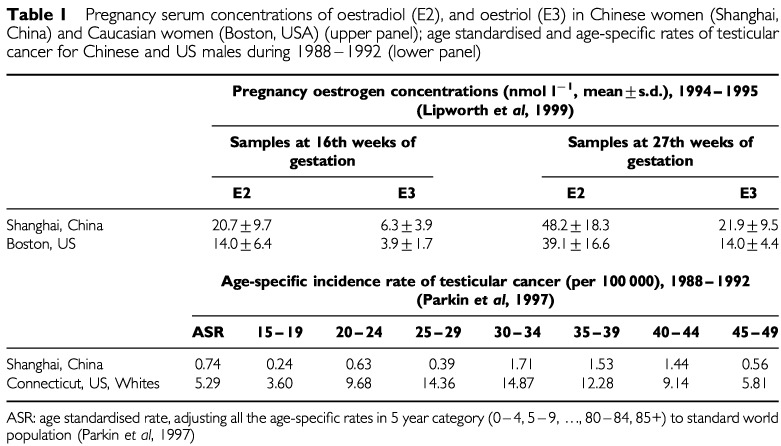Abstract
British Journal of Cancer (2002) 86, 1363–1364. DOI: 10.1038/sj/bjc/6600246 www.bjcancer.com
© 2002 Cancer Research UK
Sir
Testicular cancer has a peak incidence among men aged 25 to 34 years, suggesting early life influences (Akre et al, 1996). The hypothesis that exposure to endogenous or environmental oestrogenic compounds affects embryonic testis and increases the risk of testicular cancer has been put forth (Sharpe and Skakkeback, 1993). This intriguing hypothesis has acquired momentum and, in fact, was invoked as the main aetiologic mechanism in a recent major review (Dearnaley et al, 2001). If prenatal exposure to oestrogens were indeed important, one would expect that populations with higher levels of pregnancy oestrogens would experience a higher rate of testicular cancer. We have studied pregnancy hormone levels, including oestrogen levels, in two populations with very different rates of testicular cancer (Lipworth et al, 1999).
Adult pregnant women were recruited from maternity clinics of Beth Israel Hospital in Boston, MA, USA, and from hospitals affiliated with the Shanghai Medical University in Shanghai, China. Pregnant women were enrolled during their first prenatal visit to the collaborating maternity clinic. Eligibility requirements included that the pregnant women had to be less than 40 years old, had no more than one previous stillborn or liveborn child, took no hormonal medication during the index pregnancy and had no prior diagnosis of diabetes mellitus or thyroid disease. Three hundred and four Caucasian women in Boston and 335 Chinese women in Shanghai were studied. Pregnancy serum concentrations of oestradiol-17β (E2) and unconjugated oestriol (E3) were measured in maternal blood at weeks 16 and 27 of gestation. Details of the study have been published in this journal (Lipworth et al, 1999). Levels of E2 and E3 were consistently and significantly higher among Chinese women at both sample 1 and sample 2 (Table 1). The age-standardised rate as well as age-specific incidence rates of testicular cancer during the period of 1988–1992 for white and Chinese males (aged 15–49) were obtained from the Connecticut and the Shanghai Cancer Registries, respectively (Parkin et al, 1997). The rates for Chinese males in Shanghai at all ages were much lower than those for white males in Connecticut, despite evidence of exposure to higher levels of oestrogens in utero.
Table 1. Pregnancy serum concentrations of oestradiol (E2), and oestriol (E3) in Chinese women (Shanghai, China) and Caucasian women (Boston, USA) (upper panel); age standardised and age-specific rates of testicular cancer for Chinese and US males during 1988–1992 (lower panel).

While the hypothesis linking high oestrogen exposure with testicular cancer and other disorders of the male reproductive system is ingenious, empirical support so far has been limited. Our data are incompatible with this hypothesis and, although they do not conclusively refute it, tend to reduce its plausibility.
Acknowledgments
This study was supported in part by a grant from the US National Institutes of Health, National Cancer Institute (R01 CA54220).
References
- AkreOEkbomAHsiehCCTrichopoulosDAdamiH-O1996Testicular nonseminoma and seminoma in relation to perinatal characteristics J Natl Cancer Inst 88883889 [DOI] [PubMed] [Google Scholar]
- DearnaleyDPHuddartRAHorwichA2001Managing testicular cancer BMJ 32215831588 [DOI] [PMC free article] [PubMed] [Google Scholar]
- LipworthLHsiehCCWideLEkbomAYuSZYuGPXuBHellersteinSCarlstromKTrichopoulosDAdamiH-O1999Maternal pregnancy hormone levels in an area with a high incidence (Boston, USA) and in an area with a low incidence (Shanghai, China) of breast cancer Br J Cancer 79712 [DOI] [PMC free article] [PubMed] [Google Scholar]
- ParkinDKWhelanSLFerlayJRaymondLYoungJ1997Cancer incidence in five continents Volume VIIIARC Scientific Publications No. 143Lyon: IARC [Google Scholar]
- SharpeRMSkakkebackNE1993Are oestrogens involved in falling sperm counts and disorders of the male reproductive tract? Lancet 34113921395 [DOI] [PubMed] [Google Scholar]


